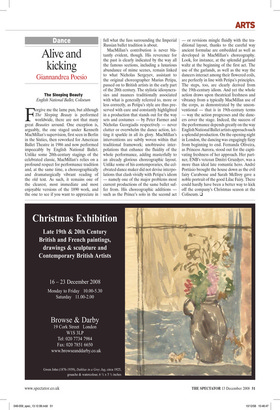Alive and kicking
Giannandrea Poesio
The sleeping Beauty English National Ballet, Coliseum
Forgive me the lame pun, but although The Sleeping Beauty is performed worldwide, there are not that many great Beauties around. One exception is, arguably, the one staged under Kenneth MacMillan’s supervision, first seen in Berlin in the Sixties, then reworked for American Ballet Theatre in 1986 and now performed impeccably by English National Ballet. Unlike some 20th-century stagings of the celebrated classic, MacMillan’s relies on a profound respect for performance tradition and, at the same time, a choreographically and dramaturgically vibrant reading of the old text. As such, it remains one of the clearest, most immediate and most enjoyable versions of the 1890 work, and the one to see if you want to appreciate in full what the fuss surrounding the Imperial Russian ballet tradition is about.
MacMillan’s contribution is never blatantly evident, though. His reverence for the past is clearly indicated by the way all the famous sections, including a luxurious abundance of mime scenes, remain linked to what Nicholas Sergeyev, assistant to the original choreographer Marius Petipa, passed on to British artists in the early part of the 20th century. The stylistic idiosyncrasies and nuances traditionally associated with what is generally referred to, more or less correctly, as Petipa’s style are thus preserved with care and constantly highlighted in a production that stands out for the way sets and costumes — by Peter Farmer and Nicholas Georgiadis respectively — never clutter or overwhelm the dance action, letting it sparkle in all its glory. MacMillan’s interventions are subtly woven within that traditional framework; unobtrusive interpolations that enhance the fluidity of the whole performance, adding masterfully to an already glorious choreographic layout. Unlike some of his contemporaries, the celebrated dance maker did not devise interpolations that clash vividly with Petipa’s idiom — namely one of the major problems most current productions of the same ballet suffer from. His choreographic additions — such as the Prince’s solo in the second act — or revisions mingle fluidly with the traditional layout, thanks to the careful way ancient formulae are embedded as well as developed in MacMillan’s choreography. Look, for instance, at the splendid garland waltz at the beginning of the first act. The use of the garlands, as well as the way the dancers interact among their flowered coils, are perfectly in line with Petipa’s principles. The steps, too, are clearly derived from the 19th-century idiom. And yet the whole action draws upon theatrical freshness and vibrancy from a typically MacMillan use of the corps, as demonstrated by the unconventional — that is in 19th-century terms — way the action progresses and the dancers cover the stage. Indeed, the success of the performance depends greatly on the way English National Ballet artists approach such a splendid production. On the opening night in London, the dancing was engagingly fizzy from beginning to end. Fernanda Oliveira, as Princess Aurora, stood out for the captivating freshness of her approach. Her partner, ENB’s veteran Dmitri Gruzdyev, was a more than ideal late romantic hero. André Portásio brought the house down as the evil fairy Carabosse and Sarah McIlroy gave a noble portrait of the good Lilac Fairy. There could hardly have been a better way to kick off the company’s Christmas season at the Coliseum. ❑










































































 Previous page
Previous page